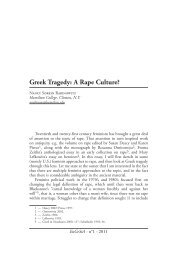Perspectives On and Of Livy's Tarpeia - EuGeStA
Perspectives On and Of Livy's Tarpeia - EuGeStA
Perspectives On and Of Livy's Tarpeia - EuGeStA
You also want an ePaper? Increase the reach of your titles
YUMPU automatically turns print PDFs into web optimized ePapers that Google loves.
176 TaRa WeLCh<br />
dolus, brings home the point, but its brevity <strong>and</strong> the use of the passive<br />
raise questions as well: who added the dolus? did the sabines seek out<br />
a traitor to exploit, who by chance (forte) ended up being <strong>Tarpeia</strong>? Or<br />
did the dolus initiate with her? dionysius’ exposition clearly identifies<br />
the origin of the compact with <strong>Tarpeia</strong>, who saw <strong>and</strong> desired the gold;<br />
her desire was Tatius’ good fortune. Livy’s compact sentence obscures the<br />
lines of responsibility, but the fact that Tatius is the subject <strong>and</strong> <strong>Tarpeia</strong><br />
the object of the narrative’s core sentence (Tatius corrumpit filiam uirginem)<br />
suggests that the dolus arose in the sabine camp first. But even in<br />
the Pisonian alternative in which <strong>Tarpeia</strong> is guilty of no treason, she is<br />
seen to be guilty of fraud (fraude), for she made a deliberately ambiguous<br />
promise, concealing her true intentions, as the sabines had done when<br />
they were preparing for war.<br />
Outright deception, present on both sides of this story, confounds<br />
accurate underst<strong>and</strong>ing. But in Livy’s narrative the difficulty in discerning<br />
goes deeper than the deliberate obfuscation of concealed intentions <strong>and</strong><br />
double dealing. There is also the challenge of interpreting what one sees.<br />
Livy’s narrative of <strong>Tarpeia</strong> is full of words of showing, seeing <strong>and</strong> seeming,<br />
which individually <strong>and</strong> together draw attention to the gap between<br />
appearance <strong>and</strong> reality. We have already seen that the sabines didn’t show<br />
their intentions for war before they waged it (nec ostenderunt). The core<br />
physical meaning of ostendo, “to stretch out (i.e., for display)” 16 , suggests<br />
that vision is important here. The sabines did not put their war preparations<br />
on display. The way they looked wasn’t the way they were. Their<br />
appearances were deceptive. <strong>On</strong>e of Tatius’ potential motives for killing<br />
<strong>Tarpeia</strong> was so that the Capitol would seem/be seen to have been taken by<br />
force – again, the fact that this may have been Tatius’ intention does not<br />
dilute the difficulty of those who are trying to determine how the Capitol<br />
was taken. The rings the sabines wear are described as being magna specie,<br />
with great appearance; species is almost always fraught with deception in<br />
the first book 17 . Like vergil’s Camilla, <strong>Tarpeia</strong> is lured by the lustre of the<br />
16 — OLd sv. ostendo entry 1 p. 1274, <strong>and</strong> see also TLL praevalente notione originaria<br />
monstr<strong>and</strong>i (sc. offerendo obtutibus sive oculorum sive mentis).<br />
17 — Species: OLd sv. entry 5, p. 1799: “Outward appearance (opp. inner nature)”, entry 6:<br />
“the semblance (of something other than is the actual case), illusory appearance, impression”, <strong>and</strong><br />
entry 7 (“an assumed appearance or veneer”). an added nuance is that of “good appearance, beauty,<br />
attractiveness” (OLd sv. entry 3b), which renders the image extra dangerous. I count eleven instances<br />
of species, including <strong>Tarpeia</strong> <strong>and</strong> Rhea silvia. Outright deception or pretense occurs on 5 occasions:<br />
1.3.11 (Rhea silvia), 1.27.2 (alban Mettius pretends alliance but intends treachery), 1.40.5 (a staged<br />
brawl to gain audience with the king), 1.41.6 (servius Tullius pretends he is consulting king Tarquin,<br />
who is in fact already deceased), <strong>and</strong> 1.56.1 (the people are employed on projects that appear small<br />
but are labor-intensive). In 4 instances something’s appearance (species) inspires deception in others:<br />
1.11.x (the rings whose appearance inspired <strong>Tarpeia</strong>), 1.7.4 (the beauty of hercules’ cows), 1.9.12<br />
(Thalassius steals a particularly pretty sabine woman), <strong>and</strong> 1.45.4 (the sabine cow of exceptional<br />
mien is in effect stolen). In the two other instances species refers to something deceptive, elusive,



